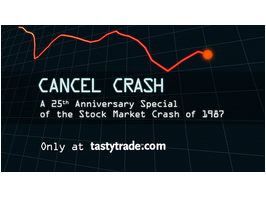 It was the defining moment of the 1980s. The New York Stock Exchange, the epicentre of the world financial markets and backbone of American capitalism, was under siege. On October 19th, 1987, the Dow Jones Industrial Average plunged 508 points, the largest single day drop in the history of the stock market. But it was on Tuesday, October 20th that the world’s financial markets came within 5 minutes of total disintegration.
It was the defining moment of the 1980s. The New York Stock Exchange, the epicentre of the world financial markets and backbone of American capitalism, was under siege. On October 19th, 1987, the Dow Jones Industrial Average plunged 508 points, the largest single day drop in the history of the stock market. But it was on Tuesday, October 20th that the world’s financial markets came within 5 minutes of total disintegration.
Released on the 25th anniversary of Black Monday, “Cancel Crash” is a documentary that follows the story of how traders, especially a group of market makers at the Chicago Board Options Exchange, dealt with the Friday before Black Monday, the infamous day itself and what followed on Terrible Tuesday when the markets were in chaos with exchanges shutting down. One exchange remained open: the Chicago Board of Trade and its Major Market Index (MMI) contract. Within the story is a fascinating retelling of how, while most traders had to sit on the sidelines that Tuesday, one market maker went over to trade the MMI deciding the thing to do when markets closed was to buy. His actions may have cancelled the crash.
505.8 points down. Off 22%. $500 billion vaporized. Oct. 19, 1987. The end. Or, so it seemed. 
“The 19th was a complete panic, but it was Oct. 20 that fascinated me. The day after the crash and what turned it around is the story I’ve always wanted to tell,” says Tony Vitale, producer of “Cancel Crash,” a TastyTrade documentary on the 1987 stock market crash.
“I was on the NYSE floor as a specialist clerk on Oct. 20, 1987, the day after the crash. There was an eerie silence. No one knew what was going to happen. No one was trading. Nothing was happening. And then people started looking at Chicago. Why Chicago? This was the New York Stock Exchange, the centre of the trading universe. What could Chicago do? This is the story of Cancel Crash. Telling this story is my dream,” Vitale says.
On Oct. 20, the Chicago Mercantile Exchange and the Chicago Board Options Exchange closed. Only the Chicago Board of Trade (CBOT) remained open. And all New York was watching as Chicago market maker Blair Hull made the decision to be the buyer of last resort, walking into the CBOT to purchase the Major Market Index contracts that others only wished to sell.
“We could breathe again”, recalls Vitale. “It was like a big huge gasp of relief and thank God we’re saved. The market had been down 508 points the day before, but it came back 250 points that day.”
“Cancel Crash” tells the story of the tense 24 hours of the trading floors by the men who lived it in their own words. The Cancel Crash story tellers include Tom Sosnoff, CEO of Tastytrade.com, founder of Think or Swim, and floor trader in 1987; Leo Melamed, now chairman emeritus of the CME; Blair Hull; Bill Johnstone, of the NYSE, and others. Spokespeople for the CBOT, site of the famous first trade, declined to be interviewed for the film, Vitale says.
 “[The crash] made us want to be smarter,” Sosnoff says. “I feel like I haven’t forgotten any of the lessons I learned. It shaped our careers all for the good.”
“[The crash] made us want to be smarter,” Sosnoff says. “I feel like I haven’t forgotten any of the lessons I learned. It shaped our careers all for the good.”
Looking back at that time and all the market events that have occurred since, Vitale says, “What happens in the markets is neither salvation, nor damnation. It’s just another cycle. It’s what life is about and that’s the story of Cancel Crash.” In addition to telling the historical tale of the trade that averted financial melt-down, the film also introduces the concept of skewness in the options market, Vitale adds.
The 1987 crash time period marked the advent of many changes, including the beginning of the end for floor trading; the rise of computer trading and the understanding that markets truly do cycle and there are opportunities to be found even in the most crushing of moments. October 1987 was the catalyst that shaped modern markets and Cancel Crash is the story to watch.
Past performance may not indicate the future, but understanding it can shape opportunities.
You can now watch the entire documentary online, here.
